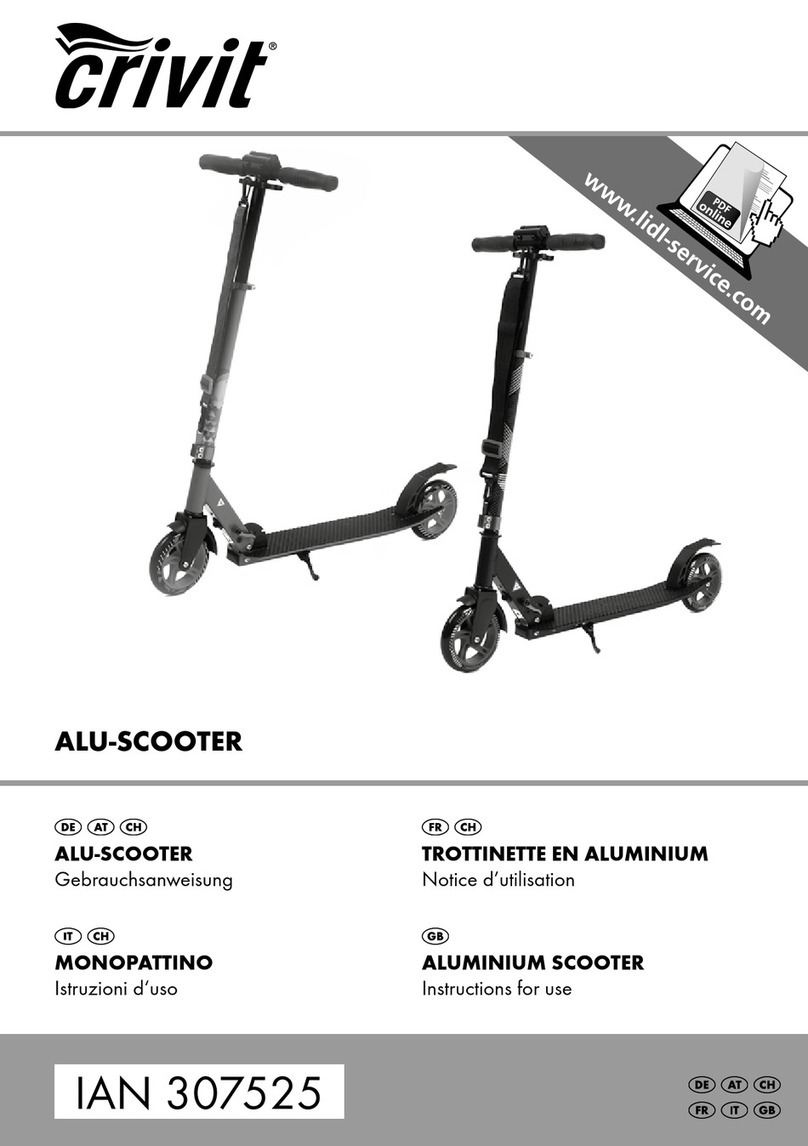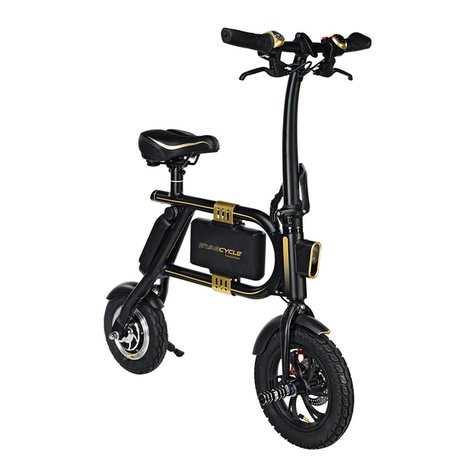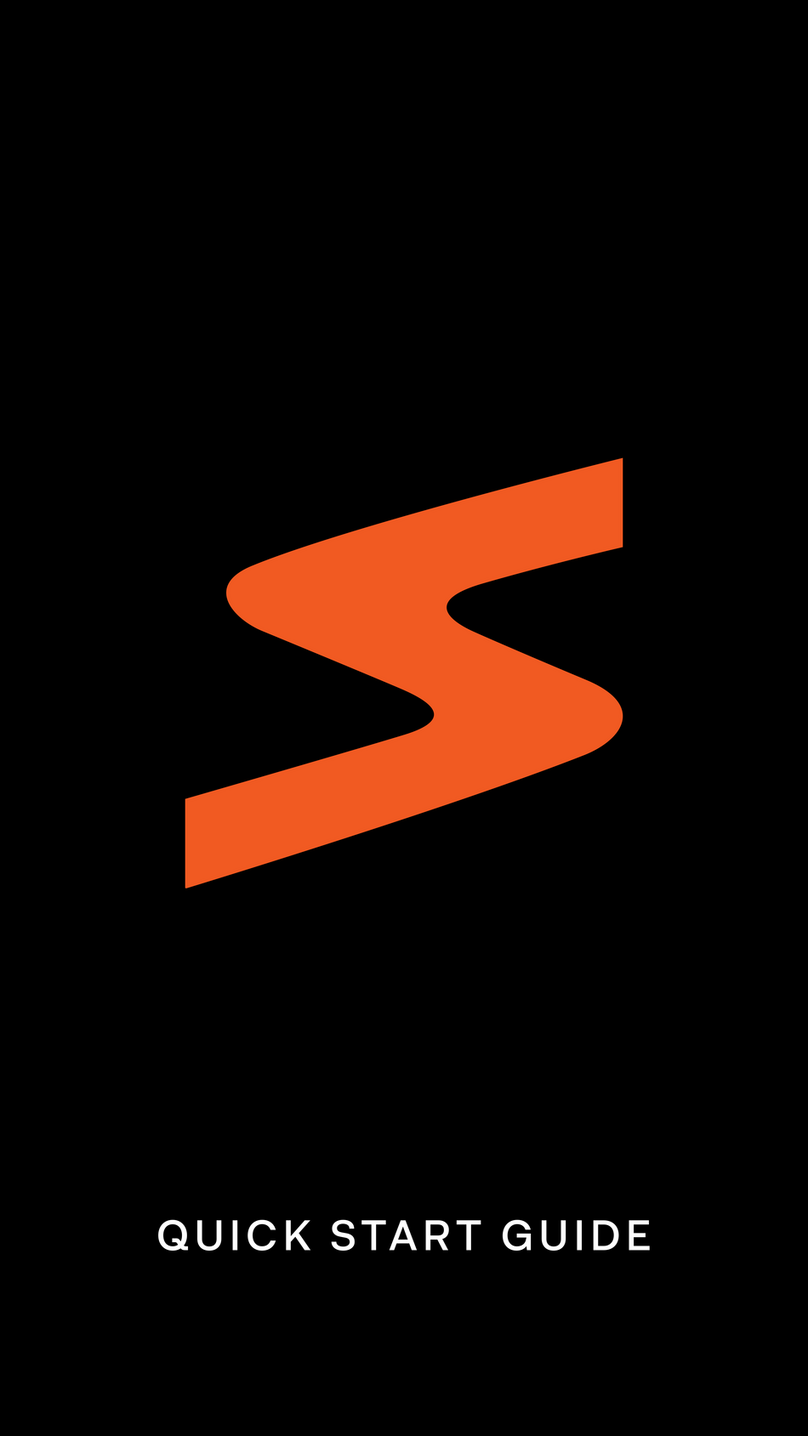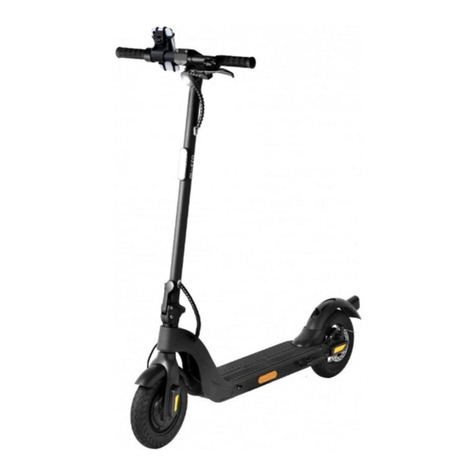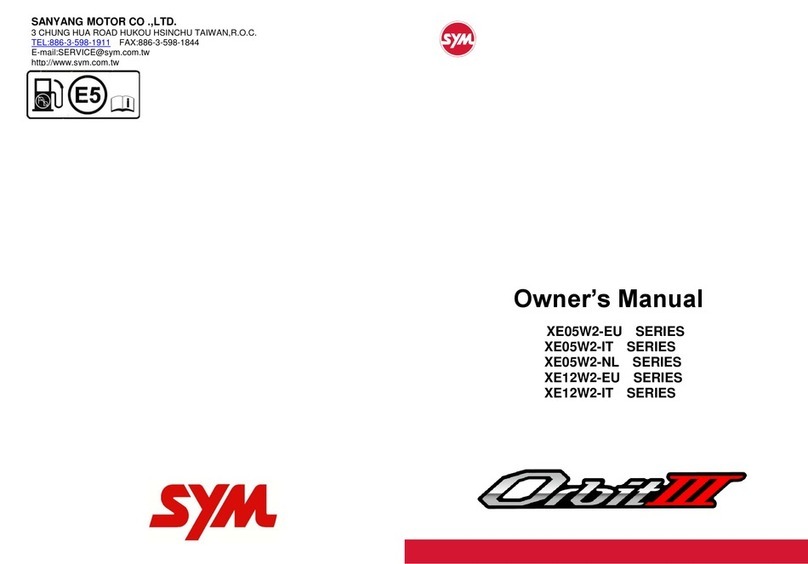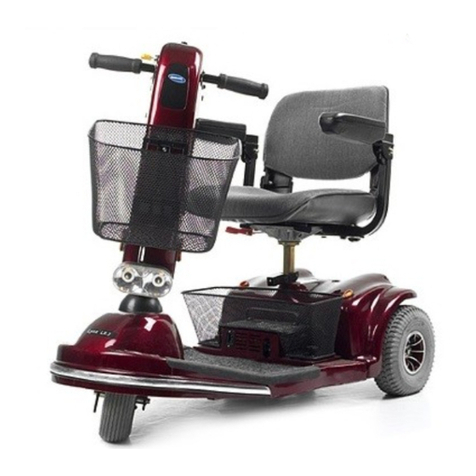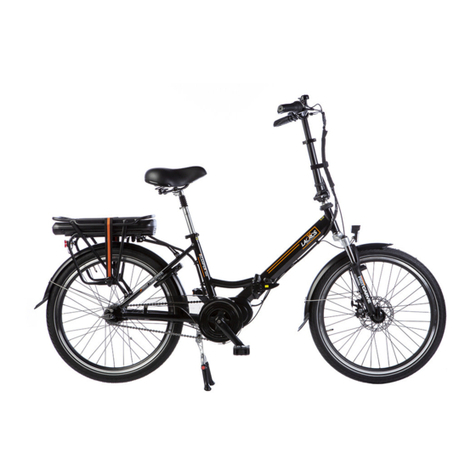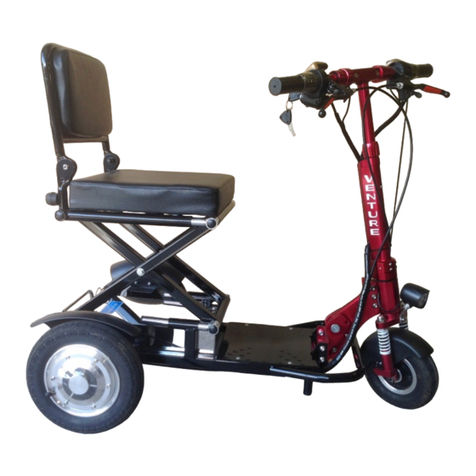Surface 604 User manual

OWNERS MANUAL

OWNERS MANUAL
2
Thank you for purchasing a Surface604
We welcome you to the exciting and revolutionary world of alternative
transportation. Your high quality, power on demand Surface604 bicycle
oers a new form of environmentally friendly transportation and rec-
reation. Throughout this Manual you will nd useful tips and important
safety, performance and maintenance information to ensure that you
enjoy all the features Surface604 bicycles have to oer for your riding
enjoyment.
IMPORTANT: Please read this Manual before taking your rst ride on
your Surface604 bicycle. It is very important to familiarize yourself with
the product to ensure you experience the bike’s full performance po-
tential, all the while ensuring your safety and riding pleasure. We also
recommend that you keep the Manual on hand for future reference.
NOTE: It is important to understand that this is not a comprehensive
use, repair or service Manual. Please contact your local Surface604
dealer for all service, repair and maintenance. Your local dealer will
also be able to refer you to additional books, DVDs, websites or cycling
clinics/classes available in your community to broaden your skills and
knowledge in bicycle use, repair and maintenance.
ABOUT THIS MANUAL: The main purpose of producing this owner’s
Manual is to ensure your safety at all times while enjoying our prod-
uct. Along with many others in the cycling community, we constantly
strive to reduce possible risks associated with our products. We also
recognize the importance of you, the rider, to clearly understand that
with proper instruction of bicycle use and maintenance, the risk of
cycling-related accidents can be reduced. It is within this context we
created the following Manual and invite you to take responsibility to
learn about how to reduce inherent risks while bicycling and enjoying
your Surface604 bicycle. We also wrote the Manual to ensure readabil-
ity and ease in eciently nding information. We strongly recommend
that you read the entire Manual and look for the WARNINGS or CAU-
TIONS we have included throughout to alert you to potential risks of
injury and/or damage.

OWNERS MANUAL
3
Contents
GENERAL WARNING .................................................................................................................................................................5
BEFORE YOU RIDE.........................................................................................................................................................5
BIKE FIT ..............................................................................................................................................................................5
SAFETY FIRST.......................................................................................................................................................................
MECHANICAL SAFETY CHECK.............................................................................................................................................6
SAFETY .........................................................................................................................................................................8
THE BASICS ........................................................................................................................................................................8
RIDING SAFETY ...................................................................................................................................................................8
CHANGING COMPONENTS OR ADDING ACCESSORIES ........................................................................................................8
FIT.................................................................................................................................................................................9
STANDOVER HEIGHT ...........................................................................................................................................................9
SURFACE604 FRAME FIT ..................................................................................................................................................10
SADDLE ADJUSTMENT......................................................................................................................................................11
HANDLEBAR HEIGHT AND ANGLE .....................................................................................................................................11
BRAKE REACH...................................................................................................................................................................11
TECHNICAL INFORMATION ..........................................................................................................................................12
WHEELS ...........................................................................................................................................................................12
SEATPOST QUICK RELEASE ..............................................................................................................................................14
BRAKES ............................................................................................................................................................................15
SHIFTING GEARS...............................................................................................................................................................16
PEDALS.............................................................................................................................................................................17
BICYCLE SUSPENSION......................................................................................................................................................17
TIRES AND TUBES.............................................................................................................................................................18
POWER ASSIST DRIVE SYSTEM........................................................................................................................................19
SERVICE......................................................................................................................................................................19
SERVICE INTERVALS .........................................................................................................................................................20
BATTERY .....................................................................................................................................................................21
PRECAUTIONS...................................................................................................................................................................21
ACCESSORIES...................................................................................................................................................................22
1
2
3
4
5
6

OWNERS MANUAL
4
Like many forms of transportation and recreation, bicycling involves
the potential risk of injury and/or damage. By choosing to cycle, you
are assuming responsibility for these risks. In an attempt to reduce the
risk, we believe you need to know and practice the rules of safe and
responsible riding and of proper use and maintenance, which will help
to reduce the risk of injury or damage. Consequently, you will nd many
“WARNINGS” and “CAUTIONS” throughout this Manual followed by dis-
cussions on the consequences in failing to inspect and maintain your
bicycle and/or following safe cycling protocol. Again, we recommend
you familiarize yourself with this information since we are highlighting
it with your safety in mind.
It is impossible to anticipate or discuss all situations or conditions in
this Manual, which may or may not lead to injury or damage while
riding this bicycle. We have taken the utmost care and attention in
manufacturing a safe and reliable product and in providing you with
this informative Manual that will assist you in reducing risks associated
while using your bicycle. However, there are risks that cannot be pre-
dicted or avoided, and consequently, are the sole responsibility of you,
the rider. Our intention here is not to cast fear in riding a bicycle, but
instead to recognize the potential dangers associated with traveling
on two wheels and thereby ensuring a safe and enjoyable experience.
• The combination of the !alert symbol and the word WARNING
indicates a potentially hazardous situation which, if not avoided,
could result in serious injury.
• The combination of the !alert symbol and the word CAUTION
indicates a potentially hazardous situation which, if not avoided,
may result in minor or moderate injury, or is an alert against
unsafe practices.
• The word CAUTION used without the safety alert symbol indicates
a situation which, if not avoided, could result in serious damage to
the bicycle or the voiding of your warranty.

OWNERS MANUAL
5
NOTE: STRONGLY RECOMMENDED, please read this Manual in its en-
tirety. Here we explain the importance of tting the bike, safety and
general maintenance. Be sure you understand each point in this section
before setting out on your rst ride. Refer to specic sections of the
Manual for detailed content to ensure you are prepared and ready for a
safe and enjoyable ride.
BIKE FIT
1The t of your bicycle is extremely important. If the bicycle is too
large or too small, this may pose a danger in causing you to lose
control or fall. In addition, proper t is essential for maximum perfor-
mance and comfort. To determine the right size of bike that suits your
body, go to Section THREE. Your dealer will also be able to assist you in
nding the right size. When referring to size, bicycles are measured
according to the frame size. This number signies the size of the frame
and the overall size of the bike.
2With the right sized frame, you can now adjust accessories to
maximize safety, comfort and performance. Start with determin-
ing whether your seat height is set correctly. To check this and/or make
adjustments, go to THREE.
3Now check to ensure the saddle is securely fastened to the post
(see Section THREE) and the post clamp is secured (see Section
FOUR). A securely fastened saddle does not move in any direction and
a secure post clamp prevents the post from sliding up or down.
4Check to see if the handlebars and stem are set at the right
height for you and are secure.
5Now check the brakes. Squeeze the brake levers. Can you oper-
ate them with ease? Do you see the front brake pads grasping
the disc when you squeeze the brake levers? It is also a good idea to lift
your bicycle, spin each wheel, grasp the brake and ensure proper func-
tion. If the brake does not function with ease, then have your local
dealer/mechanic adjust them.
6Lastly, ensure that you fully understand how to operate your new
Surface604 bicycle (see Section FOUR). Your new bicycle oers
features unlike regular pedal operated bicycles. Contact your local
dealer to have any features or functions explained to you before your
rst ride.
SAFETY FIRST!
1ALWAYS WEAR AN APPROVED HELMET WHEN RIDING YOUR SUR-
FACE604 BICYCLE.
Please refer to your helmet manufacturer’s instructions for proper t,
use and care of the helmet. Helmets are available from your dealer.
2Check to see that you have all required and recommended safety
equipment for your rst and future rides. Also, be sure that you
know all laws pertaining to cycling in your region. The laws may include
where you can cycle, the use of hand signals or the need for mandato-
ry equipment while cycling.
3Next, are your wheels securely fastened to the frame/forks?
Wheels that are not safely secure can wobble and impede the
bicycle performance or worse, dislodge while riding and cause injury.
For your Surface604 bicycle, the front wheel has a quick release
mounting mechanism and the rear wheel has a bolted mounted device.
See Section FOUR for an explanation on how to properly secure both
types of mounting devices.
4Now look at your pedals. Check to see that they are securely
fastened and the pedals spin freely.
BEFORE YOU RIDE
1

OWNERS MANUAL
6
5Your Surface604 bicycle comes equipped with a suspension fork
(except BOAR) and a suspension seat post is optional. It is very
important that you understand how the suspension works, because it
will inuence the performance and handling of the bicycle. Either con-
sult your local dealer to explain or read Section FOUR.
6Check to see if you have “toe-overlap” – this can occur with
smaller sized frames when your toe(s) make contact with the
front wheel when the wheel is turned and the pedal is in a forward
position. This can cause injury or harm to you and/or your bicycle. If
you are rubbing the front wheel (or any other part of the bicycle while
pedaling) see Section FOUR or contact your local dealer before you
ride.
7Check to see that the lighting system is operating at peak perfor-
mance. To activate the lights, press the Mode button for three
seconds and check the rear and front xture for strong light output. It
may be helpful to roll your bike up to a wall and turn the light on to see
the output level and angle of the light. Please refer to the lighting sys-
tem manufacturer’s Manual for more information about light output
and adjusting the xture angles for peak performance.
8Check to see that the battery is fully charged and operating prop-
erly. Look for a full battery charge level on the command con-
sole. If this is not the case, refer to Section FIVE on charging your bat-
tery. Always make sure your battery container is well fastened to the
frame and locked.
MECHANICAL SAFETY CHECK
Always do a complete check of the condition of your bike before ev-
ery ride. We also recommend regular maintenance of your bicycle to
prolong the life of the components and maximize safety.
Nuts, Bolts and Straps: Ensure all are secure. An easy way to
test for this is to lift the front wheel o the ground by two or
three inches and then drop the wheel. Listen, watch and feel for any-
thing loose. Do the same for the rear wheel. Next, do a quick visual and
tactile inspection of the entire bicycle. If you nd something loose,
tighten it before your ride. This is a good habit to develop before each
ride. Lastly, if you do discover something you are not sure about, please
consult your local dealer to ensure all is safe.
Tires and Wheels: Make sure your tires have the correct amount
of air pressure. Tires with too little or too much air pressure can
impede performance and be unsafe while riding your bike. To ensure
your tires are at the necessary air pressure (or psi), there are two steps
you can follow. First, if you have a tire gauge, apply it to the tire valve
and check the psi. Much like a tire on a car, the recommended psi is
stamped on the sidewall of the bicycle tire. When you are sure the tire
is set to the correct psi, squeeze the tire to familiarize yourself with
how the tire should feel to your hand. With your tires ready to roll,
slowly spin each wheel and watch for any cuts in the tread and side-
wall, or road debris lodged in the tire such as wood, glass or nails. Re-
move any debris and ALWAYS replace any tires with cuts or visual
damage before you ride. Lastly, check to ensure your wheel (or rim)
spins straight or “true” – this means that when you spin the wheel, it
does not wobble side to side or rub against your brake pads. If you nd
your wheel wobbles side to side or rubs against the brake pad even
slightly, take your bicycle to your local bicycle mechanic to have the
wheel trued.

OWNERS MANUAL
7
CAUTION:
!For your brakes to work eectively, the wheel
(or rim) must be “true.” Do not attempt to true a wheel unless
you have the knowledge, tools and experience. Truing the wheel
is better left to your local bicycle mechanic to ensure your wheel
performs properly and safely.
WARNING:
!Loose or damaged handlebar grips
can cause you to lose control of the bicycle and fall. Unplugged
handlebar ends can cut your body (handlebar ends are often cut
when the bicycle is assembled and may not be led to remove
sharp edges or spurs) and can cause serious injury in an otherwise
minor accident.
WARNING:
!Failure to conrm compatibility or to properly
install and maintain any component or accessory can result in
serious injury or damage to your bicycle.
WARNING:
!Changing components or accessories on your
bicycle may void the warranty. Please refer to your warranty and
check with your local dealer before making any changes to your
bicycle.
Brakes: Check to see the brakes are working correctly (see Sec-
tion 4.3). Squeeze the brake levers for both front and rear brakes
and look to see if the front wheel quick- release lever is closed, all
control cables are seated and securely engaged, and that the brake
discs are intact. Also, check that the brake levers, when fully squeezed,
do not touch the handle-bar. If you nd a problem, DO NOT RIDE THE
BICYCLE and take the bicycle to your local dealer for service.
Quick Release: Check to see the front wheel and seat post
quick-release mounts are properly adjusted and securely fas-
tened. (see Sections THREE and FOUR, respectively)
Handlebar and Saddle Adjustment: Check to see the handlebar
stem and suspension seat post are properly aligned and securely
fastened. Make sure the handlebar stem and suspension seat post are
parallel with the bicycle’s “center line” (imagine a straight line that runs
from the rear tire to the front tire). Also, ensure the stem and post are
clamped securely so that neither can be twisted or moved.
Handlebar Ends: Check to see the handlebar grips are secure
and in good condition.
Battery Container: Ensure the battery container is locked in
place and connected; check by depressing the mode button on
the command console to conrm digital control activation.
Bicycle Suspension: For your seat post suspension, check the
rail clamp plate screw for proper torque and that the seat post
quick-release is properly tightened (see Section FOUR for more de-
tails). For the front suspension fork, ensure that it is set correctly for
the terrain you have chosen for your ride.

OWNERS MANUAL
8
THE BASICS
1Always wear a bicycling helmet that meets
the latest certication standards and follow
the helmet manufacturer’s instructions for proper
t, use and care of your helmet. Most serious bi-
cycle injuries involve head injuries, which may
have been avoided if the rider had worn a helmet.
WARNING:
!Failure to wear your helmet when riding a bicycle
may result in serious injury.
2Always do the Mechanical Safety Check before you get on your
bike (Section ONE).
3Be competent in operating the controls on your bicycle: brakes
(Section FOUR); pedals (Section FOUR), shifting (Section FOUR)
and power assist drive system (Section FOUR).
4Be careful to keep body parts, clothing and other objects clear
from the sharp teeth of the chainrings, the moving chain, the
turning pedals and cranks, and the spinning wheels of your bicycle.
5Always wear:
Shoes that t your feet properly and grip the pedal securely. Do
not ride your bicycle barefoot or with loose tting shoes such as
sandals.
Appropriate cycling clothing that is bright, visible and t snugly to
your body. Loose clothing can tangle in your drivetrain or wheel
or be snagged by objects at the side of the road or trail.
SAFETY
2Protective eyewear to protect against airborne dirt, dust and
bugs.
6Do not jump with your Surface604 bike. Jumping a bike can be
fun, but it puts you and your bike at risk of serious harm. Jumping
causes stress on everything from the spokes to your pedals, and if you
lose control, you can cause serious injury. If you insist on jumping your
bicycle, understand that you are doing this at your own risk.
7Ride your bicycle at a speed that is appropriate for the conditions
in which you are riding.
RIDING SAFETY
1Observe all local bicycle laws and regulations. Pertinent laws in-
clude, but are not limited to, helmet laws, child carrier laws and
special bicycle trac laws. Important regulations include, but are not
limited to, licensing of bicycles, riding on sidewalks, and regulations
concerning bike path and trail use. It is your responsibility to learn and
obey all laws and all regulations that pertain to cycling in your area.
2Always respect the rights of other road or path users such as
motorists, pedestrians and other cyclists.
3Ride defensively. Always assume that others do not see you.
Never underestimate the unpredictability and risks associated
with road riding.
CHANGING COMPONENTS OR ADDING ACCESSORIES
There are a range of components and accessories available on the
market to enhance the comfort, performance and appearance of your
Surface604 bicycle. Please know that if you choose to change compo-
nents or add accessories on your bicycle, you are doing so at your own
risk. We are unable to test that all components or accessories available
on the market are compatible, reliable or safe on your Surface604 bicy-
cle. Before installing any component or accessory, please consult your
local dealer to ensure that it is compatible with your bike.

OWNERS MANUAL
9
NOTE: Correct t and properly adjusted components are essential for
maximum performance, safety and comfort while riding your Sur-
face604 bicycle. Your dealer can assist in ensuring you have the right
sized frame.
Making adjustments to your bicycle to ensure the correct t for your
body and riding conditions requires appropriate skills, special tools and
experience. Always have your dealer make the adjustments on your bi-
cycle. If you have the necessary skills, tools and experience and prefer
to make the adjustments yourself, have your dealer check your work
before riding. to specic sections of the Manual for detailed content to
ensure you are prepared and ready for a safe and enjoyable ride.
Ensure you have a Surface604 bicycle that ‘ts’ you properly. This means
that the frame is the right size and the components & parts are adjusted
to your preference. A bike that is too big, too small and/or not set up
properly is harder to control and can make for an uncomfortable ride.
STANDOVER HEIGHT
Standover height is the basic element of the bike t. For most bikes, it
is the distance from the ground to the top of the bicycle’s frame at that
point where your crotch would be if you were straddling the bike and
standing half way between the saddle and the handlebars. However,
your Surface604 frame does not have a top tube. Instead, you can fol-
low the same protocol as with other bikes but use the top of the battery
container as your guide.
FIT
3
Therefore, to check for correct standover height, straddle the bike
while wearing the kind of shoes in which you’ll be riding and bounce
vigorously on your heels. If your crotch touches the top of the battery
container, the frame is too big for you.
A bike which you ride on paved surfaces and never take o-road should
give you a minimum standover height clearance of 7 centimeters (2.8
inches). A bike that you’ll ride on unpaved surfaces should give you a
minimum of 10 Centimeters (4 inches) of standover clearance.
NOTE: If in doubt, have your dealer assist you in nding the ideal frame
for your size and riding style.
WARNING:
!If your bicycle does not t properly you may lose
control and fall.

OWNERS MANUAL
10
SURFACE604 FRAME FIT
As your Surface604 bicycle does not have a top tube you may also
use the seat tube measurement to determine proper t. The seat tube
length designation is measured as the length from the middle of the
bottom bracket to the top of the seat tube. For example, if you rode a
19’’ bicycle in the past, you may also consider a 19” Surface604 frame.
NOTE: Have your dealer assist you in nding the ideal frame for your
size, riding style and experience
SADDLE POSITION
It is very important that your saddle position is set according to your
personal preference to ensure maximum performance and comfort
while riding your bike. If you nd that the saddle is not comfortable, ask
your dealer to assist you in making any adjustments. He/she will have
the necessary tools and skills required for the adjustment. The saddle
can be adjusted in three directions:
2Up and down adjustments. Check correct saddle height:
• Sit on the saddle;
• Place one heel on a pedal;
• Rotate the crank until the pedal with your heel on it is in the down
position and the crank arm is parallel to the seat tube.
Evaluation:
If your leg is not completely straight (but not locked) and just touching
the center of the pedal, your saddle needs to be adjusted. If your hips
have to rock for the heel to reach the pedal, the saddle is too high. If
your knees are obviously bent with your heel on the pedal, your saddle
is too low. There will be a line or marking on the seat post indicating the
point at which you cannot extend the post before it is unsafe.
WARNING:
!A mounted seat post that exceeds the allowable
Minimum Insertion or Maximum Extension mark can cause injury
and/or for you to lose control of your bike and/or damage your
bicycle.

OWNERS MANUAL
11
SADDLE ADJUSTMENTS
Front and back adjustments. The saddle can be adjusted forward or
back to ensure you get optimal position for performance and comfort.
Ask your dealer to set the saddle for your optimal riding position and to
show you how to make any adjustments.
Saddle angle adjustments. The saddle angle can be adjusted either up
or down. Most riders prefer a horizontal saddle, but some also like the
saddle angle adjusted slightly up or down. Your dealer can make any
adjustments for you and/or teach you to do it yourself. If you do make
adjustments, remember that small changes to the saddle angle can
have a substantial eect on the bicycle’s performance and your com-
fort. Therefore, make small adjustments to the saddle for one direction
at a time. Go for a test ride to nd optimal position.
WARNING:
!Be sure to double check that you have securely
tightened the saddle adjusting mechanism after each adjustment
before riding. A loose saddle clamp can cause damage to your
bicycle and/or cause you to lose control of the bicycle and
fall. When the saddle is securely tightened, there is no saddle
movement in any direction. It is a good habit to periodically check
the saddle for movement before riding the bicycle. This is done
easily and quickly by grabbing the saddle and trying to move it in
dierent directions.
HANDLEBAR HEIGHT AND ANGLE
Your Surface604 bicycle comes equipped with an adjustable stem. We
recommend that you contact your local dealer for assistance in making
any adjustments to the stem. Your Surface604 dealer can help you with
any adjustments to the handlebar height and angle.
WARNING:
!The stem’s Minimum Insertion Mark must not be
visible above the top of the headset.
If you see that the Minimum Insertion Mark is visible, have your
local dealer make the necessary adjustments. A stem that
exceeds the Minimum Insertion Mark may break or damage the
fork’s steering tube, which can cause you to lose control and fall.
WARNING:
!If the stem binder bolt, handlebar binder bolt
or bar and extension clamping bolt are not securely tightened,
you could lose control of your bicycle and fall and/or damage
your bicycle. To quickly check to ensure bolts are secure, place
the front wheel between your legs and attempt to twist the
handlebar/assembly. If you can twist the stem in relation to the
front wheel, turn the handlebars in relation to the stem, or turn
the bar and extensions in relation to the handlebar, the bolts are
not fastened properly. Either fasten them yourself or see your
dealer for help. Do not ride your bicycle until you are sure all bolts
are securely fastened.
BRAKE REACH
The brake levers can be adjusted for optimal reach; however, we do
not recommend that you attempt to adjust them yourself because your
hydraulic disc braking system is uid lled. If you have small hands or
nd it dicult to squeeze your brake levers, ask your local dealer to
assist you in making an adjustment or replace the levers with ones that
suit your needs or preferences.
WARNING:
!The shorter the brake lever reach, the more
critical it is to have correctly adjusted brakes, so that full
breaking power can be applied within available brake lever travel.
Insucient brake lever travel can result in serious injury.

OWNERS MANUAL
12
Understanding how your Surface604 bicycle works will contribute
greatly to your safety, performance and overall riding enjoyment. We
strongly recommend that you become knowledgeable of the basic
technical information as explained in the following pages and if re-
quired, contact your local dealer for clarication.
WHEELS
FRONT WHEEL QUICK RELEASE
ADJUSTING THE QUICK RELEASE MECHANISM
The wheel hub is clamped in place by the force of the quick release
cam pushing against one dropout and pulling the tension-adjusting nut,
by way of the skewer, against the other dropout. The tension- adjusting
nut controls the amount of clamping force. Turning the tension-adjust-
ing nut clockwise while keeping the cam lever from rotating increases
clamping force; turning it counterclockwise while keeping the cam le-
ver from rotating reduces clamping force. Less than half a turn of the
tension-adjusting nut can make the dierence between safe clamping
force and unsafe clamping force.
TECHNICAL INFO
4
WARNING:
!Riding with an improperly mounted or adjusted
wheel quick release can cause the wheel to wobble or disengage
from the fork, causing injury or to the rider. Therefore, it is ssential
that you:
Ask your dealer to help ensure that you know how to remove
and install the wheel properly.
Understand and apply the correct technique for mounting
your wheel with the quick release device.
Check to see that the wheel is correctly mounted before ev-
ery ride.
WARNING:
!Holding the nut with one hand and turning the
lever like a wing nut with the other hand until everything is as tight
as you can get it will not clamp the wheel safely in the dropouts.
Full force of the cam action is needed to clamp the wheel
securely.ery ride.
The wheel quick release uses a cam action to clamp the bike’s wheel in
place. Because of its adjustable nature, it is critical that you understand
how it works, how to use it properly, and how much force you need to
apply to secure the wheel.

OWNERS MANUAL
13
REMOVING AND INSTALLING A QUICK RELEASE FRONT WHEEL
REMOVING THE QUICK RELEASE WHEEL
A. Move the wheel’s quick release lever from the locked or CLOSED
position to the OPEN position.
B. To disengage the secondary quick release, loosen the tension- ad-
justing nut enough to allow removing the wheel.
C. Now raise the front wheel a few inches o the ground and bang the
top of the wheel with the palm of your hand to knock the wheel out
of the front fork.
A. Move the quick release lever, so that it curves away from the wheel.
This is the OPEN position.
B. With the steering fork facing forward, insert the wheel between the
fork blades so that the axle seats rmly at the tip of the slots, which
are at the tips of the fork blades – the fork dropouts. The quick re-
lease lever should be on the left side of the bicycle.
C. Holding the quick release lever in the OPEN position with your right
hand, tighten the tension adjusting nut with your left hand until n-
ger tight against the fork dropout.
D. While pushing the wheel rmly to the top of the slots in the fork
dropouts, and at the same time centering the wheel rim in the fork,
move the quick release lever upwards and swing it into the CLOSED
position. The lever should now be parallel to the fork blade and
curved toward the wheel.
F. Re-engage the brake quick release mechanism to restore correct
brake pad to disc clearance; spin the wheel to make sure that it is
centered in the frame and clears the disc, then squeeze the brake
lever and make sure that the brakes are operating correctly.
FRONT WHEEL SECONDARY RETENTION DEVICES
Your Surface604 bicycle has a secondary wheel retention device to
keep the wheel from disengaging from the front forks, if the quick re-
lease is incorrectly mounted. However, the secondary mounting device
is not a substitute for correct quick release adjustments.
For more information, contact your Surface604 dealer.
INSTALLING A QUICK RELEASE FRONT WHEEL
WARNING:
!Removing or disabling the retention device is
extremely dangerous and may lead to serious injury or death. It
may also void the warranty.
CAUTION:
!Your Surface604 bicycle is equipped with disc brakes.
Be very careful not to damage the disc, caliper or brake pads when
re-inserting the disc into the caliper. Never activate a disc brakes
control lever unless the disc is correctly inserted in the caliper.
CAUTION:
!Securely clamping the wheel takes considerable
force. If you can fully close the quick release without wrapping
your ngers around the fork blade for leverage, and the lever does
not leave a clear imprint in the palm of your hand, the tension is
insucient. Open the lever, turn the tension-adjusting nut clockwise a
quarter turn, then try again. If the lever cannot be pushed all the way
to a position parallel to the fork blade, return the lever to the OPEN
position; then turn the tension-adjusting nut counter-clockwise one-
quarter turn and try tightening the lever again.

OWNERS MANUAL
14
REMOVING AND INSTALLING BOLT-ON REAR WHEEL
TO INSTALL - Shift the rear derailleur to its outermost position
and pull the derailleur back with your right hand.
Put the chain on the smallest sprocket. Then, insert the wheel
into the frame dropouts and pull it all the way in to the dropouts.
The axle nut washers should be on the outside, between the
frame and the axle nut.
Make sure that the axle groove is pointing directly toward the
oor (6 o’clock).
Using the correct size wrench (15mm), tighten the axle nuts as
tightly as you can. Torque to 40 N.m. (30 ft/lbs)
Push the rear derailleur back into position.
Re-engage the brake quick release mechanism to restore correct
brake pad to disc clearance; spin the wheel to make sure it is cen-
ter in the frame and clears the brake pads; then squeeze the brake
lever and make sure that the brakes are operating correctly.
Reconnect the electric motor cables and fasten with zap- straps
in the required locations.
REMOVING AND INSTALLING BOLT-ON REAR WHEEL
TO REMOVE - Disconnect the electric motor cables and zap-
straps (located on the bottom left hand chain stay).
Shift the rear derailleur to high gear (the smallest rear sprocket)
and pull the derailleur body back with your right hand.
Using the correct size wrench, loosen the two axle nuts.
Lift the rear wheel o the ground a few inches and, with the
derailleur still pulled back, push the wheel forward and down
until it comes out of the rear dropouts.
WARNING:
!The motor acts as a rear hub and should not
be adjusted once the rear wheel is properly mounted.
WARNING:
!Riding with an improperly tightened seat post can
allow the seat to turn or move and cause you to lose control and fall.
SEATPOST QUICK RELEASE
The seat post quick release clamp works exactly like the front wheel
quick release. While a quick release looks like a long bolt with a lever
on one end and a nut on the other, the quick release uses a cam action
to rmly clamp the seat post.
The quick release cam squeezes the seat collar around the seat post to
hold the seat post securely in place. The tension- adjusting nut controls
the amount of clamping force. Turning the tension-adjusting nut clockwise
while keeping the cam lever from rotating increases the clamping force;
turning it counterclockwise while keeping the cam lever from rotating re-
duces clamping force. Less than half a turn of the tension-adjusting nut
can make the dierence between safe and unsafe clamping force.
CAUTION:
!Your Surface604 bicycle is equipped with
disc brakes. Be very careful not to damage the disc, caliper or brake
pads when re-inserting the disc into the caliper. Never activate a disc
brakes control lever unless the disc is correctly inserted in the caliper.

OWNERS MANUAL
15
WARNING:
!Riding with an improperly adjusted brakes or
worn brake pads is dangerous and can result in serious injury. Check
to ensure your brakes are working properly before every ride.
WARNING:
!The motor in the rear wheel also becomes a
generator when using the rear brake. Please note that the
generative mode does not replace the existing brakes, but increases
considerably the braking quality and will help you slow down when
needed. It activates as soon as the rear brake lever is activated.
BRAKES
Your Surface604 comes equipped with a front and rear hydraulic disc
brake system. Braking systems today are very eective in providing
responsive braking power.
• Applying brakes too hard or too suddenly can lock up a wheel,
which can cause you to lose control and fall. Sudden or excessive
application of the front brake may pitch the rider over the
handlebars, which may result in serious injury.
• Your hydraulic disc braking system, when properly set up and
maintained, is extremely powerful. Take extra care in becoming
familiar with these brakes and exercise particular care when using
them.
• Always apply your rear brake (RH lever) rst.
• Disc brakes can get extremely hot with extended use. Be careful
not to touch a disc brake until it has had time to cool.
• It is very important for your safety that you learn how the brake
system works and which brake levers engage the front and back
brakes on your bike.
The braking action on your bicycle is a function of the friction between
the brake surface – the disc – and the brake pad. To ensure you have
maximum friction available, keep the disc and caliper clean and free of
lubricants, waxes or polishes.
Make sure the brake levers are positioned correctly by testing to see
that your hands can reach and squeeze the brake levers comfortably.
The lever reach can be adjusted to suit your hand.
When you apply one or both brakes, the bike begins to slow, but your
body wants to continue at the speed at which it was going. This causes
a transfer of weight to the front wheel (or, under heavy braking, around
the front wheel hub, which could send you ying over the handlebars).
A wheel with more weight on it will accept greater brake pressure be-
fore lockup; a wheel with less weight will lock up with less brake pres-
sure. So, as you apply brakes and your weight is transferred forward,
you need to shift your body toward the rear of the bike, to transfer
weight back on to the rear wheel and at the same time, you need to
both decrease rear braking and increase front braking force.
This is even more important on descents, because descents shift
weight forward. Two keys to eective speed control and safe stopping
are controlling wheel lockup and weight transfer. This weight transfer
is even more pronounced with having a front suspension fork on your
Surface604 bicycle.
Front suspension “dips” or “travels” under braking, increasing the
weight transfer. Everything changes when you ride on loose surfaces
or in wet weather. Tire adhesion is reduced, so the wheels have less
cornering and braking traction and can lock up with less brake force.
Moisture or dirt on the brake discs reduces their ability to grip. To main-
tain control on loose or wet surfaces it is wise to go more slowly.

OWNERS MANUAL
16
SHIFTING GEARS
Your bicycle has a combination of a derailleur drive train and a variable
power assist drive system.
The gear-changing mechanism on your Surface604 bicycle includes:
• Shifters on the handlebar
• Rear derailleur
• Rear freewheel sprocket cluster
• One chain ring
• Drivetrain
Surface604 bicycles come equipped with lever style shifters. A down-
shift is a shift to a “slower” gear, one which is easier to pedal. An up
shift is a shift to a “faster”, harder to pedal gear.
For example, you can select a gear which will make pedaling easier
on a hill (make a downshift) in one of two ways: shift the chain down
the gear “steps” to a smaller gear at the front, or up the gear “steps”
to a larger gear at the rear. So, at the rear gear cluster, what is called
a downshift actually looks like an up shift. The way to keep things
straight in your head is to remember that shifting the chain in towards
the center line of the bike is for accelerating and climbing and is called
downshifting. Moving the chain out or away from the bike's centerline
is for speed and is called up shifting.
CAUTION:
!Never move the shifter while pedaling
backward, nor pedal backwards after having moved the shifter.
This could jam the chain and cause serious damage to the bicycle.
SHIFTING THE REAR DERAILLEUR
The rear derailleur is controlled by the right lever on the handlebar.
The function of the rear derailleur is to move the drive chain from one
gear sprocket to another. The smaller sprockets on the gear cluster
produce higher gear ratios. Pedaling in the higher gears requires great-
er pedaling eort, but takes you a greater distance with each revolution
of the pedal cranks. The larger sprockets produce lower gear ratios.
Using them requires less pedaling eort, but takes you a shorter dis-
tance with each pedal crank revolution. Moving the chain from a small-
er sprocket of the gear cluster to a larger sprocket results in what we
are calling a downshift. Moving the chain to a larger sprocket results
in an up shift. In order for the derailleur to move the chain from one
sprocket to another, the rider must be pedaling forward.
SHIFTING THE FRONT DERAILLEUR
Shifting the chain onto a smaller chain ring makes pedaling easier (a
downshift). Shifting to a larger chain ring makes pedaling harder (an
up shift).

OWNERS MANUAL
17
PEDALS
Your Surface604 bicycle comes equipped with standard pedals. Be sure
to check that when you are properly tted and positioned on the bicycle
you do not have ‘toe overlap’. Toe Overlap is when your toe can touch
the front wheel when you turn the handlebars to steer, while a pedal
is in the forward-most position. This is common on smaller framed
bicycles, and is avoided by keeping the inside pedal up and the outside
pedal down when turning.
BICYCLE SUSPENSION
Your Surface604 bicycle is equipped with a suspension system. Be sure
to read and follow the suspension manufacturer’s set up and service
instructions.
GREAR COMBINATION
The combination of largest rear and smallest front gears is for the
steepest hills. The smallest rear and largest front combination is for
the greatest speed. It is not necessary to shift gears in sequence. In-
stead, nd the “starting gear” which is right for your level of ability – a
gear which is hard enough for quick acceleration but easy enough to let
you start from a stop without wobbling – and experiment with up shift-
ing and downshifting to get a feel for the dierent gear combinations.
If you have diculties with shifting the problem could be mechanical
adjustment. See your dealer for assistance.
SET UP NOTES FOR FRONT SUSPENSION
Your Surface604 bicycle is equipped with a front suspension system
(except BOAR).
With front suspension, increased speed may also increase your risk of
injury. When braking, the front of your bicycle will dip and may cause
you to lose control and fall. Learn to handle your suspension system
safely.
Suspension can increase control and comfort by allowing the wheels
to better follow the terrain. This enhanced capability may allow you to
ride faster, but you must not confuse the enhanced performance of the
bicycle with your own capabilities as a rider. Proceed carefully until you
have learned to handle the full potential of your bike.
SET UP NOTES FOR SEAT POST SUSPENSION
Seat post suspension can be purchased from Surface604, it can be
tuned to your particular weight, riding style and terrain on which you
ride - by adjusting the preload. The preload can be adjusted for riders
from 144 to 220.5 lb. (65 to 100kg).
Before you make any adjustments, take a ride and feel the function of
the seat post. If you feel too much “SAG” (the saddle moves down and
back when you mount the saddle), you have to increase the preload of
the seat post, in order to compensate the “SAG”.
A certain amount of “SAG” - between 0 - 10mm (4 inches) is allowed,
but it depends on your weight and the terrain on which you are riding.
Changing the preload alters the “SAG” and the rmness of the initial
seat post movement. In order to increase the preload, you have to turn
the adjuster plug at the bottom of seat post in a clockwise direction
using a 6mm Allen key.
Do not turn the adjuster plug counterclockwise beyond the initial po-
sition at delivery, as this could result in failure of the preload adjuster
plug and can strip the threads.
In this basic position, around 10mm (.4 inches) of the seat post thread
should be visible.
WARNING:
!Toe Overlap could cause you to lose control
and fall. If you have toe overlap, exercise extra care when turning.
WARNING:
!Failure to maintain, check and properly adjust
the suspension system may result in suspension malfunction,
which may cause you to lose control and fall.
WARNING:
!Changing suspension adjustment can change
the handling and braking characteristics of your bicycle. Never
change suspension adjustment unless you are thoroughly familiar
with the suspension system manufacturer’s instructions. Always
check for changes in the handling and braking of the bicycle after
a suspension adjustment.

OWNERS MANUAL
18
TIRES AND TUBES
Bicycle tires are available in many designs and specications, ranging
from general purpose designs to tires designed to perform best under
very specic weather or terrain conditions. If, once you have gained
experience with your new Surface604 bike, you feel that a dierent tire
might better suit your riding needs, your dealer can help you select the
most appropriate design.
Changing to a tire which is a larger or smaller width will alter the han-
dling characteristics of your bicycle and in some cases may make it
unsafe to ride. With your dealer’s help, be sure to select an inner tube
that correctly corresponds with the size of the new tire.
In some cases, particularly when you select a larger diameter tire, you
may nd that the clearance between the tire and the bicycle frame is
reduced. This may cause damage to other parts of the bicycle, in par-
ticular, the frame. Furthermore, this is potentially dangerous and may
cause injury. It may also void your warranty.
The size, pressure rating, and on some high- performance tires, the
specic recommended use, are marked on the sidewall of the tire. It is
important to know the tire pressure for the tire you are using.
The best and safest way to inate a bicycle tire to the correct pressure
is with a bicycle pump, which has a built-in pressure gauge.
Tire pressure is given either as maximum pressure or as a pressure
range. How a tire performs under dierent terrain or weather condi-
tions depends largely on tire pressure. Inating the tire slightly near its
maximum recommended pressure gives the lowest rolling resistance,
but also produces the bumpiest or most sensitive ride depending on the
type of terrain you ride.
Tire pressure that is too low for your weight and the riding conditions
can cause a puncture of the tube by allowing the tire to deform enough
to pinch the inner tube between the rim and the riding surface.
High pressures work best on smooth, dry pavement. Very low pres-
sures, at the bottom of the recommended pressure range, give the best
performance on smooth, slick terrain such as hard- packed clay, and on
deep, loose surfaces such as deep, dry sand.
Ask your dealer to recommend the best tire pressure for the kind of
riding you will most often do and have the dealer inate your tires to
that pressure. Some tires may need to be brought up to pressure every
week or two.
WARNING:
!Never inate a tire beyond maximum pressure
marked on the tire’s sidewall. Exceeding the recommended
maximum pressure may blow the tire o the rim, which could
cause damage to the bike and injury to the rider and bystanders.
WARNING:
!There is a safety risk in using gas station air
hoses or other air compressors. They are not made for bicycle tires.
They move a large volume of air very rapidly and can quickly raise
the pressure in your tire, which can cause the tube to explode.
CAUTION:
!Pencil type automotive tire gauges can be
inaccurate and should not be relied upon for consistent, accurate
pressure readings. Instead, use a high-quality dial gauge obtained
from your local bike dealer.

OWNERS MANUAL
19
POWER ASSIST DRIVE SYSTEM
The power assist drive system, consisting of a motor, battery pack, and
digital command console, is what makes your Surface604 unique from
other bicycles on the market. This intelligent energy management sys-
tem allows you to travel long distances without exhausting yourself.
It is therefore very important that you know how to operate the sys-
tem with condence and ease. Please refer to the supplementary User
Manual for information about operating the Power-assist Drive System
installed on your Surface604 E-Bike
TIRE VALVES
Surface604 bicycles use Schrader tire valves:
The Schrader valve (see Fig 4.7b) is like the valve on a car tire. To in-
ate a Schrader valve tube, remove the valve cap and clamp the pump
tting onto the end of the valve stem. To let air out of a Schrader valve,
depress the pin in the end of the valve stem with the end of a key or
other appropriate object. The bicycle pump you use must have the t-
ting appropriate to the valve stem on the bicycle.
If you want to learn more about proper maintenance and service on
your bicycle, consider the following options:
Regardless of the option you choose, we strongly recommend that you
have your local dealer check to ensure the quality of your adjustment or
service the rst time you perform the work. This will ensure you have
completed the work properly. This will likely mean that your dealer’s
mechanic will need to take the time to evaluate your work and result in
modest charge for his/her time. This small investment in ensuring your
adjustment or service is correct will contribute greatly in reducing the
possibility of damage or harm to you or your bicycle, and will assist you
in developing your skills in bicycle maintenance.
SERVICE
5
WARNING:
!Please note that bicycle technology is
continuously changing to improve performance and use, but this has
also made components mechanically more complex. It is therefore
very important that you minimize the chance of an accident or
potential injury by having any repair or maintenance, not discussed
in this Manual, be performed by your local Surface604 bicycle
dealer. In addition, your individual maintenance requirements will
be determined by a number of factors from your riding style to
your geographic location. Your dealer can assist you in identifying
maintenance requirements for your specic riding needs.
WARNING:
!Many bicycle service and repair tasks require
specic knowledge, tools and skills. Do not attempt to perform
any adjustment or service to your Surface604 bicycle that you are
unfamiliar with or are ill equipped to perform properly. Improper
adjustments or service can result in damage to your bicycle (and
its components) or result in an accident while riding, which can
damage your bicycle and/or cause you serious injury or death.

OWNERS MANUAL
20
SERVICE INTERVALS
Regular maintenance and service will help ensure the bicycle operates
at an optimal performance level, will help promote the life and depen-
dency of your components and will reduce the risk of injury and/or
death inherently associated with bicycling.
1BREAK-IN PERIOD: Much like a new automobile, your bike needs
time to break in before riding it for extended distances. It is very
important to have your bicycle serviced soon after 10-15 hours of rid-
ing to have any adjustments made. Refer to your Mechanical Safety
Check Section to help guide you through some things that may need
readjustment. However, even if you feel you have completed all adjust-
ments properly, we strongly recommend that you have your local deal-
er evaluate your bicycle at this time.
Dealers often recommend that you return the bicycle in 30 days for a
checkup. Overall, if you think at any time there is something wrong with
your bicycle, always visit your local dealer before riding the bicycle.
2BEFORE EVERY RIDE: See the Mechanical Safety Check in Sec-
tion.
3AFTER EVERY LONG OR HARD RIDE: If the bike has been exposed
to water or grit (or after at least every 150 kms, 95 miles or 5
hours), clean the bike and lightly oil the chain. This is important to pre-
vent rust or avoidable wear on your components. Be sure to wipe o any
excess oil or lubricant when nished. As for how much lubrication is
appropriate and the frequency of application, consult your local dealer.
Dierent climatic conditions will determine which type and frequency
of lubricant is best suited for your riding environment. It is not recom-
mended to use pressured water to wash your bicycle to avoid unwant-
ed damage to components.
CHECK-LIST
Squeeze both brake levers so that the brakes are fully engaged
and rock the bicycle from front to back. Does everything feel
solid? Are there any clunking or strange sounds when you rock the bike
front to back? If there is a clunking sound, you may have a loose head-
set – have your dealer check it.
Lift the front wheel and swing it from side to side to reenact
steering when riding. Does it swing smoothly? If you feel any
resistance, binding or roughness in the steering, your headset may be
too tight – have your dealer check it.
Grab one pedal and rock it toward and away from the centerline
of the bike; then do the same with the other pedal. Anything feel
loose? If so, have your dealer check it.
Take a look at the front brake disc. Starting to look worn or not
hitting the disc squarely? Time to have the dealer adjust or re-
place them.
Carefully check the control cables and cable housings. Any rust?
Kinks? Fraying? If so, have your dealer replace them.
Squeeze each adjoining pair of spokes on either side of each
wheel between your thumb and index nger. Do they all feel
about the same? If any feel loose, have your dealer check the wheel for
tension and trueness.
Check the frame, particularly in the area around all tube joints,
the handlebars, the stem, and the seat post for any deep scratch-
es, cracks or discoloration. These are all signs of stress-caused fatigue
and indicate that a part is at the end of its useful life and needs to be
replaced.
Check to make sure that all parts and accessories are still se-
cure, and tighten any that require adjustment.
Recharge battery after it has cooled to room temperature.
Table of contents
